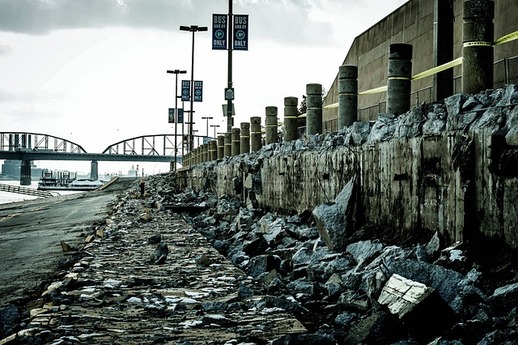
Although concrete is durable and may give the impression that it is impermeable, water damage can seriously affect both the structural integrity and aesthetic appeal of concrete surfaces, whether the damage is the result of flooding, leaks, or other water-related accidents. This article will explore the complexities of repairing concrete that has been impacted by water damage, offering a thorough how-to manual for homeowners, professionals, and property managers who must take on the task of reviving concrete surfaces that have been impacted by moisture.
Despite being praised for its strength, concrete is susceptible to deterioration from water, which can cause cracks, spalling, and other issues. Whether the damage is to a driveway, basement floor, or other concrete buildings, restoring the material calls for a methodical and careful approach.
Our goal in examining the procedures and methods for repairing concrete that has been impacted by water is to equip readers with the information they need to deal with water-related occurrences in a productive manner. This guide is an invaluable resource for anyone attempting to restore their water-damaged concrete to its previous state, guaranteeing that both functionality and aesthetic appeal are restored. It covers everything from determining the degree of the damage to putting repairs and protective measures in place.
See also our post on How to assess water damage in a commercial property
Understanding Water Damage
1. Identify the Source
Pinpoint the origin of water damage before initiating any restoration efforts. Inspect for leaks, poor drainage, or prolonged exposure to moisture. Understanding the root cause is vital for effective restoration.
2. Assess the Severity
Evaluate the extent of the water damage. Minor surface issues may only require cosmetic repairs, while more severe damage might demand a thorough restoration. Identifying the severity aids in planning appropriate restoration strategies.
3. Remove Excess Water
Before embarking on the restoration process, eliminate any standing water or excess moisture. This prevents further damage and creates a suitable environment for restoration materials to adhere properly.
4. Test for Structural Integrity
Ensure the concrete’s structural integrity hasn’t been compromised. Perform tests to assess load-bearing capacity and stability. Address any structural concerns before proceeding with cosmetic repairs.
5. Investigate Mold Growth
Water damage often leads to mold growth. Inspect the affected area for signs of mold and mildew. If present, incorporate mold remediation measures into the restoration process to prevent future issues.
Restoration Techniques
1. Surface Cleaning
a. Scrubbing
Thoroughly scrub the damaged concrete surface using a stiff brush or broom to remove dirt, debris, and any loose particles. This prepares the area for subsequent restoration steps.
b. Pressure Washing
Utilize a pressure washer to clean deeply ingrained stains and contaminants. Adjust the pressure according to the concrete’s condition, ensuring effective cleaning without causing additional damage.
c. Chemical Cleaners
Apply suitable concrete cleaners to tackle specific stains. Follow manufacturer guidelines, and choose cleaners compatible with your concrete type to avoid unwanted reactions.
d. Acid Etching
For stubborn stains or discoloration, consider acid etching. Exercise caution and adhere to safety guidelines when using acid-based solutions to avoid harm to yourself and the environment.
e. Neutralization
After using acid-based cleaners, neutralize the concrete with a baking soda solution to prevent any residual acidity. Neutralization ensures a clean and safe surface for further restoration.
2. Repairs and Patching
a. Filling Cracks
Identify and fill cracks with a high-quality concrete patching compound. Ensure the product adheres well to the existing concrete and follows the manufacturer’s instructions for optimal results.
b. Resurfacing
For larger damaged areas, resurfacing is an effective technique. Apply a concrete resurfacer to create a new, uniform surface. Follow mixing and application guidelines closely for a seamless finish.
c. Epoxy Injection
Address structural cracks by injecting epoxy resin. This technique restores the concrete’s strength and prevents further deterioration. Seek professional guidance for precise application.
d. Bonding Agents
Use bonding agents before applying new concrete or patching compounds. These agents enhance adhesion, promoting a strong bond between the existing and repaired surfaces.
e. Concrete Overlay
Apply a concrete overlay for a decorative and protective finish. Overlays can enhance the appearance of the restored concrete while providing an additional layer of protection against future damage.
3. Waterproofing
a. Surface Sealers
Apply a high-quality concrete sealer to the restored surface. Surface sealers create a protective barrier against water penetration, reducing the risk of future damage.
b. Penetrating Sealers
For deeper protection, opt for penetrating sealers that infiltrate the concrete pores. These sealers enhance durability and resist water infiltration from within the structure.
c. Crystalline Waterproofing
Consider crystalline waterproofing additives for concrete mixtures. These additives react with moisture to form crystals within the concrete, improving its resistance to water damage over time.
d. Silicone Sealants
Apply silicone-based sealants to joints and cracks as an additional layer of defense. Silicone sealants remain flexible, accommodating concrete movement and preventing water intrusion.
e. Regular Maintenance
Establish a routine maintenance schedule for reapplication of sealers and inspections. Regular upkeep ensures prolonged protection against water damage and preserves the restored concrete’s integrity.
See also our post on How to deal with water damage in a condo
Prevention Strategies
1. Improve Drainage
a. Redirect Downspouts
Ensure downspouts direct water away from the foundation. Redirecting water flow prevents pooling near concrete structures, reducing the risk of water damage.
b. Install Drainage Systems
Implement proper drainage systems, such as French drains, to channel excess water away from concrete surfaces. Adequate drainage minimizes the impact of heavy rainfall and groundwater.
c. Grade Slopes Appropriately
Modify the landscape to create proper slopes away from structures. Adequate grading prevents water accumulation, safeguarding concrete foundations from potential damage.
d. Install Gutters
Install gutters along the edges of roofs to collect and redirect rainwater. Well-maintained gutters prevent water from cascading onto concrete surfaces, reducing exposure to moisture.
e. Permeable Pavements
Consider permeable pavement options in areas with high water exposure. These surfaces allow water to pass through, reducing the risk of pooling and minimizing water-related damage.
2. Apply Waterproofing Membranes
a. Liquid Applied Membranes
Use liquid applied membranes to create a seamless, waterproof barrier. These membranes adhere to the concrete surface, providing reliable protection against water infiltration.
b. Sheet Membranes
Install sheet membranes for added waterproofing. These durable membranes act as a physical barrier, shielding concrete from moisture and preventing water-related deterioration.
c. Hot-Applied Membranes
In areas with extreme conditions, opt for hot-applied membranes. These substances form a robust, long-lasting protective layer, ensuring effective resistance to water damage.
d. Membrane Overlays
Apply membrane overlays as an additional layer of protection. Overlays enhance waterproofing capabilities, safeguarding concrete from various water-related threats.
e. Professional Installation
Engage professional contractors for the installation of waterproofing membranes. Their expertise ensures proper application, maximizing the effectiveness of the protective barrier.
See also our post on A Comprehensive Water Damage Restoration Services Checklist
Conclusion
Concrete damage restoration is a methodical process that starts with locating the damage and ends with applying preventative and restoration techniques. With the knowledge of the concepts presented in this manual, people can effectively address water damage problems and prolong the life and durability of concrete buildings.
Frequent upkeep and preventative actions not only repair damaged concrete but also help build a robust and waterproof structure. As we confront the difficulties caused by water damage, the information provided in this guide is a useful tool for making sure that concrete surfaces are long-lasting and sustainable.






